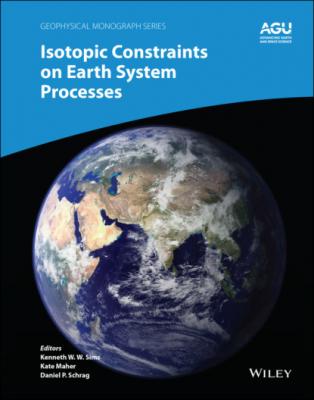Isotopic Constraints on Earth System Processes. Группа авторов
Чтение книги онлайн.
Читать онлайн книгу Isotopic Constraints on Earth System Processes - Группа авторов страница 15
 into the mechanisms by which diffusion takes place in these materials. Experimental studies documenting kinetic isotope fractionation in silicate materials of interest to geochemistry and cosmochemistry did not start until much later.
into the mechanisms by which diffusion takes place in these materials. Experimental studies documenting kinetic isotope fractionation in silicate materials of interest to geochemistry and cosmochemistry did not start until much later.
The following sections discuss high‐temperature laboratory diffusion experiments that quantified kinetic isotopic fractionations associated with diffusion in silicate liquids and minerals. The results of these experiments are used to identify the processes responsible for chemical gradients in silicate materials from natural settings. Experiments quantifying kinetic isotope fractionation by evaporation from silicate liquids of interest to cosmochemistry are discussed in a final section. The experimental and analytical methods are only briefly described, and the interested reader will find them discussed in detail in the various papers referenced in connection with kinetic isotope fractionation in laboratory and natural samples.
1.2. DIFFUSION IN MULTI‐COMPONENT CONDENSED SYSTEMS: THEORY AND DEFINITIONS
1.2.1. Fick’s Laws and the Diffusion Matrix
Fick’s first law of diffusion
is often used to characterize the particle or molar flux Ji (i.e., particles or moles of i per cm2 per second) in terms of the gradient in particle or molar density ρ i (particles or moles of i per cm3) and a proportionality constant called the diffusion coefficient Di with units of length square per unit of time. Fick proposed this simple flux law in 1855 for physical particles by analogy to Fourier’s law of heat conduction. With this representation of the flux, the one‐dimensional conservation equation of ρ i, often referred to as Fick’s second law, is
However, Fick’s law is known to be inadequate for representing the flux due to chemical diffusion in a multi‐component, non‐ideal system such as a silicate liquid. It cannot explain, for example, uphill diffusion, such as that shown later for Al2O3 in Fig. 1.3, or that the rate of diffusion of a component in a multi‐component system depends on the direction of diffusion in composition space.
Onsager (1945) showed that a way to deal with transport in a multi‐component system is to express the diffusive flux of a component as a linear combination of the concentration gradients of all the independent components in the system. The one‐dimensional diffusive flux of component i in an n‐component liquid is then given by
where Dij are elements of a (n‐1) by (n‐1) diffusion matrix with the nth component taken as the dependent component. For example, equation 1.3 for the ternary system CaO‐Al2O3‐SiO2 can be written in matrix form as
(1.4)
when SiO2 is taken as the dependent component. The flux of the SiO2 can be calculated using
Another issue that is especially relevant in natural silicate liquids is that the driving force for chemical diffusion is chemical potential gradients ∇ μ i ( μ i now denotes chemical potential, not reduced mass). The more general version of equation 1.1 is
(1.5)
where the Li is called the phenomenological coefficient for diffusion and
1.2.2. Effective Binary Diffusion Coefficients
When the formulation of the diffusive flux given previously is applied to multi‐component geologically relevant silicate materials, one is faced with the problem that to date only one complete diffusion matrix for an igneous melt (an 8‐component basaltic melt) has been reported (Guo & Zhang, 2018). When there is a lack of a full diffusion matrix for a specific system of interest, what is commonly done is to represent the multi‐component system as if it were a binary system made up of the component of interest with all the other components taken together as a second component. The